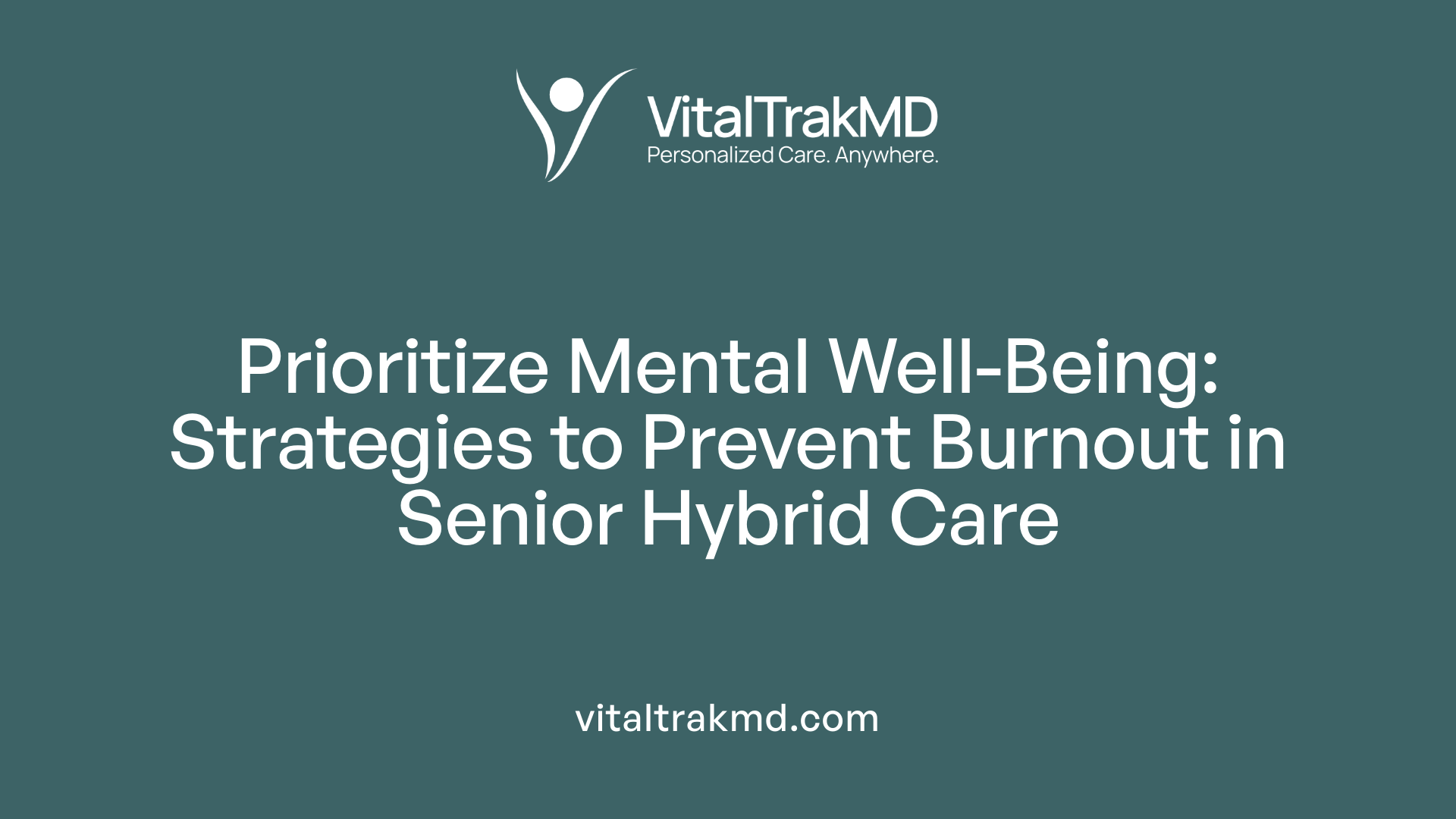How Hybrid Care Prevents Senior Burnout in Managing Their Health

Understanding the Value of Hybrid Healthcare for Seniors
As the landscape of healthcare evolves, hybrid models combining in-person and remote services are transforming how seniors manage their health. This approach not only enhances access and continuity of care but also plays a crucial role in preventing burnout among seniors and healthcare providers alike. Delving into strategies, benefits, and effective practices, this article explores how hybrid care models serve as a cornerstone for healthier, more engaged senior populations.
Benefits of Hybrid Healthcare Approaches for Senior Health Management

What are the benefits of hybrid healthcare approaches for senior health management?
Hybrid healthcare models combine traditional in-person visits with telehealth services and digital tools to improve the quality and accessibility of care for seniors. This approach offers numerous advantages that directly benefit both patients and caregivers.
One significant benefit is increased accessibility, particularly for seniors with mobility challenges or those living in remote areas. Telehealth platforms enable seniors to consult healthcare professionals without the need for travel, saving time and reducing physical strain. This continuous connection helps in early detection of health issues and ensures timely interventions.
Hybrid models also promote better care continuity. Regular virtual check-ins, remote symptom monitoring, and digital communication channels keep seniors engaged with their healthcare providers. These features promote consistent management of chronic conditions, which can lead to improved health outcomes and reduced hospitalizations.
Furthermore, hybrid care offers greater convenience for seniors and their caregivers. By decreasing the frequency of in-person appointments, it lessens the logistical and emotional burdens associated with travel and waiting times. This flexibility enhances patient satisfaction and helps caregivers manage their responsibilities more effectively.
Cost reduction is another key advantage. Fewer in-person visits translate to lower transportation expenses, fewer missed appointments, and reduced demand on healthcare facilities. These savings benefit both healthcare systems and families, easing financial stress.
Additionally, hybrid healthcare supports addressing healthcare provider shortages and long wait times. Telemedicine expands service capacity, providing more immediate access to specialists and primary care providers, especially in underserved or rural areas.
Overall, hybrid healthcare creates a more adaptable, patient-centered system. It encourages engagement, optimizes resource use, and supports the physical and mental health needs of seniors. By fostering a flexible approach to care delivery, hybrid models can significantly enhance the quality of life for older adults.
| Aspect | Benefit | Additional Detail |
|---|---|---|
| Accessibility | Easier access for seniors with mobility issues or in remote areas | Reduces need for travel, facilitates early intervention |
| Care Continuity | Consistent communication and monitoring | Maintains ongoing health management and reduces emergency visits |
| Caregiver Burden Reduction | Less travel and appointment management | Decreases stress and time commitments |
| Cost Savings | Reduced transportation and facility costs | Less financial strain on families and health systems |
| Addressing Provider Shortages | Virtual access in underserved regions | Expands reach beyond traditional clinics |
| Mental and Physical Health | Personalized, timely interventions | Supports overall well-being and health stability |
Implementing hybrid practicess in senior healthcare leverages technology to make care more accessible and personalized, fostering healthier aging and happier caregivers.
Strategies for Leveraging Hybrid Care to Minimize Senior Burnout
What strategies can be used to utilize hybrid care in reducing burnout among seniors?
Implementing hybrid care models involves blending traditional in-person health services with telehealth and remote monitoring tools. This approach allows healthcare providers to maintain consistent contact with seniors through virtual check-ins, which can be crucial for early detection of health issues. These virtual visits help reduce the need for frequent hospital visits, lowering stress and physical burden on seniors.
In addition, utilizing immersive training techniques like virtual reality (VR) can support caregivers and seniors alike. VR scenarios simulate difficult situations, helping caregivers develop better coping strategies and emotional resilience. This technology also enables seniors to feel more connected and engaged, which can improve their mental health and overall satisfaction with the care they receive.
Effective care relies on well-coordinated, interdisciplinary teams. Clear communication and collaboration among healthcare professionals, social workers, and caregivers ensure that seniors’ needs are comprehensively addressed. This team approach reduces fragmentation of care and alleviates the emotional toll on individual caregivers.
Providing respite care services is another critical strategy. Respite care offers temporary relief for primary caregivers, allowing them to rest and recharge. Support groups and emotional counseling further improve mental health by providing social connection and a platform to share experiences and coping strategies.
Promoting self-care and social engagement among caregivers is vital. Educational programs focusing on stress management, setting boundaries, and maintaining social networks help caregivers sustain their emotional well-being. Encouraging these practices improves their capacity to deliver compassionate care without becoming overwhelmed.
Integrating these strategies within hybrid care models results in a more resilient, supported care environment that benefits both seniors and their caregivers. This holistic approach aims to reduce burnout, improve health outcomes, and enhance the overall quality of life.
| Strategy | Description | Benefits |
|---|---|---|
| Use of telehealth & remote monitoring | Regular virtual check-ins & health tracking | Early detection & reduced hospital visits |
| Immersive training (VR) | Simulating real-life scenarios for caregivers | Builds confidence and emotional resilience |
| Coordinated care teams | Interdisciplinary collaboration | Less fragmentation, more comprehensive care |
| Respite care & support services | Temporary relief for caregivers, emotional support groups | Prevents burnout, reduces emotional strain |
| Promote self-care | Education, social activities, boundary setting | Maintains mental health, improves care quality |
What are some specific ways to expand hybrid care services?
Expanding hybrid care services could involve adopting new telemedicine technologies that enable remote consultations and chronic disease management. Hospitals and clinics can train staff to efficiently operate these systems, ensuring seniors receive continuous care.
Developing accessible online platforms for caregiver support groups enhances community connections and shared learning. Offering virtual workshops on caregiving skills and stress management helps build caregiver resilience.
Integrating wearable health devices that monitor vital signs in real time provides data for proactive care interventions. These devices alert caregivers and healthcare providers about potential health issues before they escalate.
Partnerships with community organizations can extend support outside medical settings, offering social activities and emotional support tailored for seniors and caregivers. Such collaborations foster a comprehensive support network embedded within the community.
By combining technological advancements with community engagement, hybrid care can become more inclusive, accessible, and effective in reducing burnout among seniors and their caregivers.
The Role of Virtual Care and Remote Monitoring in Preventing Senior Burnout
How does virtual care and remote monitoring contribute to preventing senior burnout?
Virtual care and remote monitoring offer innovative ways to support seniors' health outside traditional clinical settings. These technologies make healthcare more accessible and convenient, reducing the stress and logistical challenges often associated with in-person visits. Seniors can manage their health from the comfort of their homes, which helps minimize feelings of frustration and helplessness.
Continuous symptom monitoring is a vital part of virtual healthcare. Devices and systems that track vital signs, symptoms, and other health indicators provide real-time data to healthcare providers. Prompt alerts and interventions help prevent health escalations, maintaining chronic conditions effectively and avoiding emergency situations that can lead to elevated stress levels.
Ensuring equitable access to these services is essential. User-friendly interfaces, simplified technology, and options like audio-only consultations make virtual care accessible to seniors with diverse levels of digital literacy and those without advanced devices. This approach reduces barriers, minimizes technical difficulties, and encourages consistent use, supporting overall well-being.
The emotional and physical burdens of caregiving can significantly impact both caregivers and seniors. Remote management technologies lessen the need for frequent transportation to healthcare facilities, easing the logistical and emotional strain. This streamlining of healthcare interactions can diminish caregiver stress, allowing them to provide better support and reducing their risk of burnout.
Moreover, virtual care fosters a stronger sense of connection and support. Regular virtual interactions help seniors feel more connected with healthcare providers and loved ones, reducing feelings of isolation. By maintaining a sense of control over their health and ensuring timely support, seniors experience fewer stressors that might contribute to burnout.
In sum, integrating virtual care and remote monitoring into senior health management plays a crucial role in creating a less stressful, more supportive environment. These technologies not only improve health outcomes but also enhance emotional resilience, helping seniors retain independence, connection, and vitality while reducing the risk of burnout.
How Hybrid Care Prevents Senior Burnout in Managing Their Health
How can hybrid care models prevent senior burnout in managing health?
Hybrid care models combine virtual and in-person care approaches to create a more flexible and supportive healthcare environment for seniors. This innovative model aims to address the physical, emotional, and mental challenges that seniors often face when managing chronic conditions or complex health needs.
One significant benefit of hybrid care is the reduction of stress associated with frequent trips to healthcare facilities. Seniors can access virtual consultations and remote monitoring tools, allowing them to receive care from the comfort of their homes. This flexibility not only minimizes physical strain but also helps alleviate emotional fatigue caused by logistical barriers.
Integration of continuous support and early intervention is another notable advantage. Through telehealth platforms and wearable devices, healthcare providers can monitor health status in real-time, identifying potential issues before they escalate. This proactive approach helps prevent health deterioration and reduces the anxiety that often accompanies health concerns.
Coordination of care within hybrid models fosters improved communication among healthcare providers, patients, and caregivers. Such cooperation decreases frustrations and feelings of isolation by keeping seniors informed and involved in their treatment plans.
Empowering seniors through increased control over their healthcare routines is a crucial aspect of hybrid care. When patients can manage appointments and access support digitally, they experience greater autonomy. This sense of control enhances their confidence and engagement in their health management.
Furthermore, the early detection of problems and prompt responses facilitated by hybrid systems contribute significantly to preventing serious health complications. Preventative care and regular follow-up reduce hospitalizations and enable seniors to maintain independence longer.
In summary, hybrid care models improve the overall healthcare experience for seniors by making it more accessible, personalized, and less stressful. They foster an environment where seniors feel supported in managing their health, thereby lowering the risk of burnout and promoting healthier aging.
Additional insights on hybrid care and senior health
| Aspect of Hybrid Care | Benefit for Seniors | Details/Impact |
|---|---|---|
| Flexibility | Reduced stress | Virtual consultations and adjustable schedules |
| Continuous support | Better health outcomes | Real-time monitoring and early intervention |
| Care coordination | Less frustration | Improved communication among healthcare team |
| Empowerment | Increased autonomy | Control over health routines and decision-making |
| Preventative focus | Reduced health deterioration | Regular check-ups and remote assessment |
Efforts to implement hybrid models are growing, with evidence suggesting higher patient satisfaction and better health engagement among seniors. This approach aligns with the goal of making healthcare more adaptable to individual needs, especially for an aging population vulnerable to burnout and health decline.
Impact of Hybrid Care on Healthcare Professionals’ Work Environment in Senior Care

How does hybrid care impact healthcare professionals' workload and work environment in senior care?
Hybrid care models are transforming the way healthcare professionals, especially in senior care, manage their workload and work environment. By integrating virtual support roles with traditional bedside care, these models allow for greater flexibility and efficiency.
One significant benefit is the deployment of virtual nurses who handle administrative responsibilities remotely. Tasks such as admissions, discharges, documentation, and care planning can be managed online. This reduces the burden on onsite nurses, freeing them to focus more on patient interaction and complex clinical procedures.
During peak seasons, like flu outbreaks, virtual staffing options and on-demand support enable organizations to optimize nurse allocation. This flexible staffing reduces burnout by balancing workloads and preventing staff from becoming overwhelmed.
Telehealth technologies facilitate in-person visits and remote consultations, leading to more streamlined workflows. Despite the potential for additional documentation through electronic health records (EHR), clinicians often adapt efficiently. Many report that these tools help manage the increased administrative demands without compromising care quality or next-day documentation.
Tools like the Synergy model are also aiding in better workload management by enhancing care coordination and resource utilization. These innovations can improve staff satisfaction by making care delivery more predictable and manageable.
However, the transition to hybrid models is not without challenges. Some staff experience increased documentation needs or face systemic barriers such as limited technology infrastructure and workflow adjustments. During crises like the COVID-19 pandemic, these challenges intensified, highlighting the importance of continuous systemic support.
Despite some hurdles, well-implemented hybrid care positively influences the work environment. It supports team collaboration, reduces feelings of isolation, and alleviates some sources of burnout. Overall, hybrid care offers an adaptable framework that, when properly managed, enhances staff well-being and care quality in senior care settings.
Effective Hybrid Physical Therapy Strategies for Seniors
What are effective hybrid physical therapy strategies to prevent senior burnout?
Preventing burnout among seniors undergoing physical therapy involves a strategic blend of innovative practices designed to support their physical and mental well-being. One effective approach is integrating both tele-rehabilitation sessions and in-person therapies. This combination offers seniors the flexibility and convenience of remote exercises, complemented by hands-on care when necessary.
Utilizing remote monitoring devices plays a crucial role in this hybrid model. These tools can track progress accurately, provide real-time feedback, and keep seniors engaged with their therapy routines. This not only encourages independence and motivation but also reduces the cognitive and emotional load often associated with treatment plans.
Financial sustainability and patient care quality are further enhanced by offering a mix of cash-based services alongside traditional insurance-covered treatments. This model allows therapists to have more control over their schedules and workloads, leading to less administrative stress and more personalized care delivery.
Implementing these strategies benefits both caregivers and seniors, helping maintain motivation and reducing feelings of helplessness or fatigue. Additionally, healthcare providers focusing on professional growth and boundary-setting safeguard their mental health while continuing to deliver compassionate care.
A multifaceted approach that includes self-care, peer support, and ongoing professional development creates a resilient environment where seniors can thrive physically and emotionally, minimizing burnout risks.
Mental Health Management and Burnout Prevention in Senior Hybrid Healthcare

What role does mental health management play in preventing senior burnout in hybrid healthcare settings?
Mental health management is crucial in preventing burnout among senior healthcare workers operating within hybrid care models. It involves both individual-centered approaches and organizational strategies designed to support mental well-being.
On an individual level, interventions such as mindfulness practices, stress coping skills training, and easy access to digital mental health tools can help seniors manage the emotional and psychological demands of their roles. These resources aid in reducing emotional fatigue, anxiety, and feelings of depersonalization, which are core aspects of burnout.
Organizational support is equally important. Clear guidelines, open channels of communication, and a culture that normalizes discussions about mental health foster an environment where seniors feel safe to express concerns and seek help. For example, resources like The Manager’s Toolkit provided by mental health authorities help leaders respond empathetically to mental health issues, creating systemic change that addresses toxic behaviors and stressful workplace dynamics.
Managers themselves play a vital role by maintaining their own mental resilience through practices like mindfulness, seeking peer support, and building interpersonal connections. Strong managerial support can reinforce a supportive atmosphere, reduce feelings of isolation, and promote team cohesion.
Addressing systemic issues such as workplace toxicity, high workload, and administrative burdens is also essential. Creating a work environment that values mental health, prioritizes work-life balance, and offers professional development opportunities directly helps mitigate burnout risk.
Additionally, integrating mental health discussions into routine check-ins and providing awareness programs reduce stigma and encourage proactive engagement with mental health resources.
Implementation of mindfulness, counseling, and digital mental health tools
Healthcare organizations are increasingly adopting digital mental health tools, including teletherapy, mindfulness apps, and online support groups, to make mental health resources accessible. These tools are especially beneficial for seniors who may face mobility issues or time constraints.
Mindfulness sessions and counseling programs delivered virtually can help seniors develop resilience and better emotional regulation skills, which are essential given the emotional rigors of hybrid healthcare roles.
Organizational support via guidelines and open communication
Establishing formal guidelines and policies that prioritize mental health helps create an inclusive culture. Regular training sessions, mental health awareness campaigns, and accessible reporting mechanisms encourage open dialogue.
Creating an environment where seniors and all staff can openly discuss mental health concerns without fear of stigma is vital for early intervention and sustained well-being.
Manager support and interpersonal connection
Managers are pivotal in monitoring and supporting mental health. Regular one-on-one meetings, peer support groups, and team-building activities foster trust and personal connection.
Encouraging managers to practice self-compassion and emotional intelligence enhances their capacity to support staff effectively. Such supportive leadership directly impacts overall team morale and resilience.
Addressing workplace toxicity and systemic issues
Toxic work environments, characterized by bullying, favoritism, or unrealistic expectations, significantly contribute to burnout.
Implementing zero-tolerance policies, promoting respectful communication, and addressing systemic inefficiencies are necessary steps. Systemic change, alongside individual support, makes sustainable improvements in senior staff mental health.
| Aspect | Strategies | Expected Outcomes |
|---|---|---|
| Individual Support | Mindfulness, counseling, digital tools | Reduced stress, emotional exhaustion |
| Organizational Policies | Guidelines, open communication, stigma reduction | Supportive environment, early problem detection |
| Manager Role | Supportive leadership, self-care practices | Increased trust, team cohesion |
| Systemic Changes | Address toxicity, workload, systemic barriers | Long-term mental wellness, reduced burnout |
In conclusion, effectively managing mental health in hybrid healthcare settings is a multifaceted endeavor. It requires committed leadership, accessible resources, supportive organizational culture, and proactive systemic reforms. When these elements are integrated, they create a sustainable environment that reduces burnout risk among senior healthcare workers, enhancing their well-being and the quality of care they provide.
The Future of Senior Healthcare
The integration of hybrid care models signifies a transformative step towards more sustainable, accessible, and personalized healthcare for seniors. By reducing physical and emotional burdens and fostering a culture of proactive, continuous support, hybrid care not only prevents burnout but also enhances overall well-being. As technologies advance and care strategies evolve, embracing hybrid approaches will be crucial for building resilient healthcare systems capable of meeting the complex needs of an aging population. Ongoing commitment to innovation, staff support, and patient-centered care will ensure that senior health management continues to improve, empowering seniors to lead healthier, more engaged lives.
References
- Nurses' Job Burnout: A Hybrid Concept Analysis - PMC
- Use of Home Care Services Reduces Care-Related Strain ...
- Hybrid workforce model serves as antidote to nursing burnout
- Avoid Burnout With a Hybrid Physical Therapy Model
- Tips for Managers in a Hybrid Workplace
- The Benefits Of Hybrid Work Models In Healthcare
- What Is Hybrid Healthcare? | Tools, Benefits, and Solutions
- 4 Benefits of Telemedicine for Seniors
- The Future of Health Care Is Hybrid
Recent articles
Want to Feel Better and Live Healthier?
Join hundreds of patients taking control of their health with personalized care that fits their life – not the other way around.
Rated 4.8/5 by 32+ customers







